My mom kept suggesting that she wanted to turn part of the grass in her modestly sized yard into a new flower garden. She wanted it to be surrounded by bricks and to mirror another garden she had that was under a tree and not doing all that well. So, we got to digging, and buying dirt and some starter plants — and, voila! — her new little garden idea became a reality.
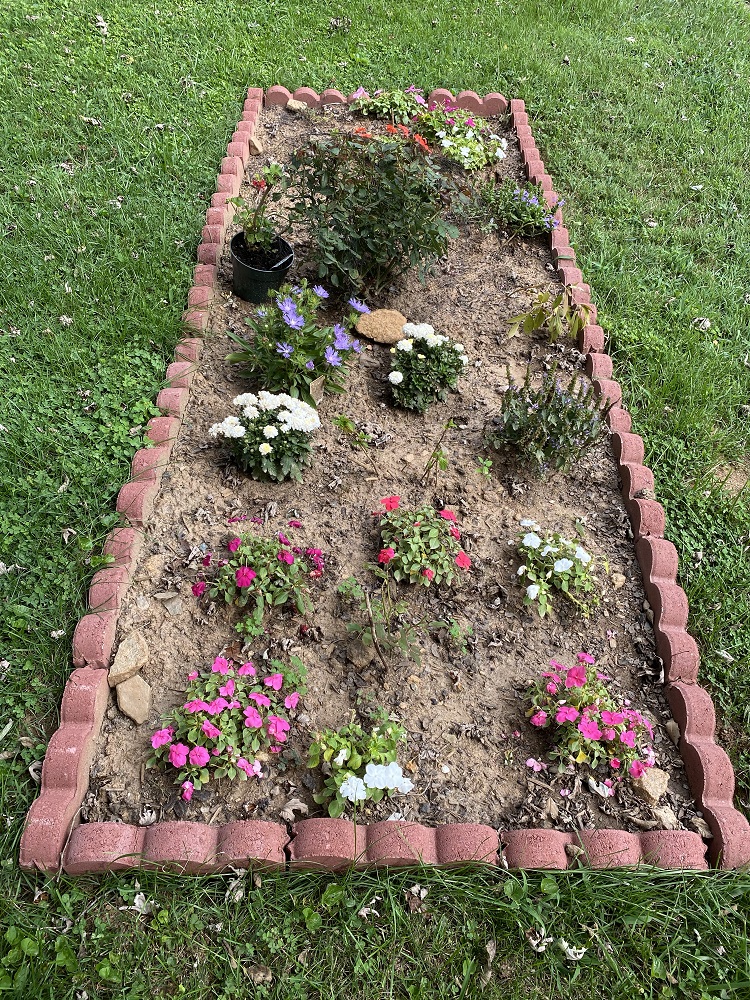
The Primary Problem: Hungry deer like to eat flowers
We started with a knockout rose, some impatiens, mums and a couple others. But we just weren’t so sure about how the neighborhood deer would behave around it. Well, truthfully, we figured they would eat some of it, because they had been making us miserable for the past few years. For decades, she never really had a problem, but construction of new houses and loss of woods probably has forced them to look for more sources of food.
More and more of my mom’s flowers have been disappearing before they even have a chance to bloom. It didn’t take long to find out. The deer came and nibbled off many of the flowers and buds, and ripped some out of the ground. Even the “deer resistant” flowers were not entirely safe. The impatiens almost disappeared one day; and they did not recover very well before their expiration in the fall. A very disappointing result.
Deer Solution #1: Bird netting
We spent the summer trying to save the plants from the deer by using bird netting. I bought a large swatch of plastic, black netting with square holes that are about 1 centimeter or so across. I thought it would be okay for bees to get through if they really wanted to, but the deer were my main concern. She covered many of her plants with the netting, but the deer still nibbled around the edges, especially the hydrangeas.
What was covered was mostly left alone, but it didn’t look nice — kind of like a spider web halo. Mostly we were wrapping the plants so tightly that the flowers were getting smooshed and misshapen. The buds would poke through the holes, and the deer would come around and eat the ones they could get access to.
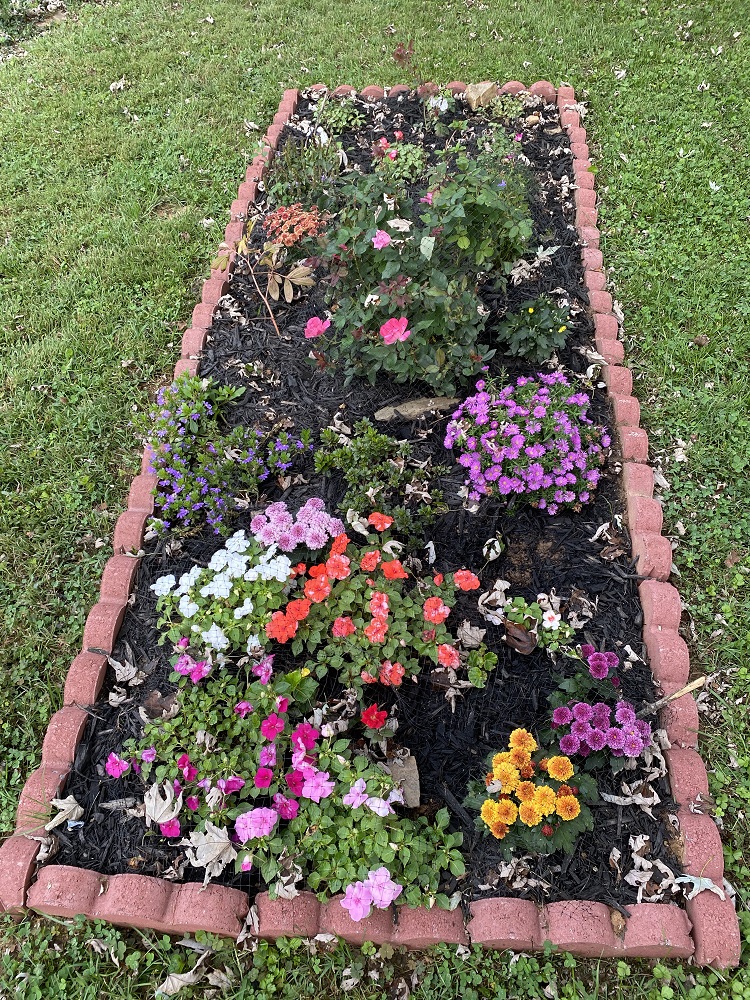
Mom said she wished she could have tulips — her favorite flower that made her feel young, filling her mind with pleasant girlhood memories. So, I wanted to make that happen, but we both knew the deer would eat all of the tulip tops for sure. It was September already, and the bulbs had to go in the ground to get ready for next spring.
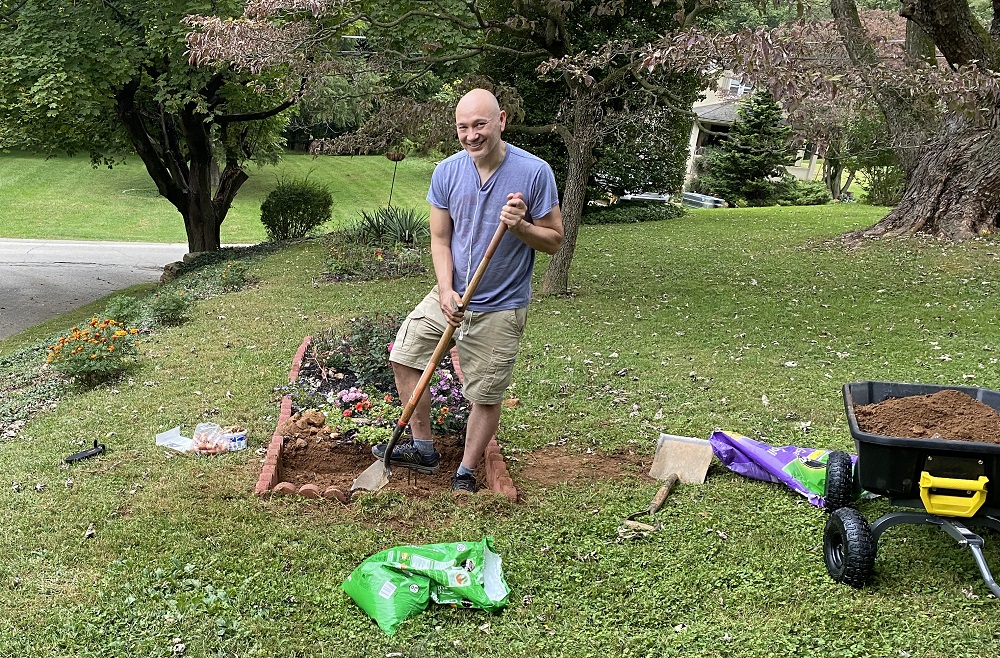
We dug an extension and planted the bulbs on the bottom, and then I covered them with pansies (another favorite food of the deer). This time, I got some short metal stakes that had a loop on the top of them. I wanted to put the stake part in the ground, and have the loop hold the net up above the flowers. We tried to cut individual pieces of netting at first, and to weigh the edges down with small stones.
It became obvious that wouldn’t work. So, I cut one big sheet of netting for the entire small garden. And then bought more stakes to hold the edges down, as well as prop up the middle. I did not think the net would be high enough for the tulips to bloom fully, and the knockout rose in the middle just looked awkward. But we let it be.
When the tulips started to bud, the deer somehow still chomped off a couple of the flowers off. How rude.
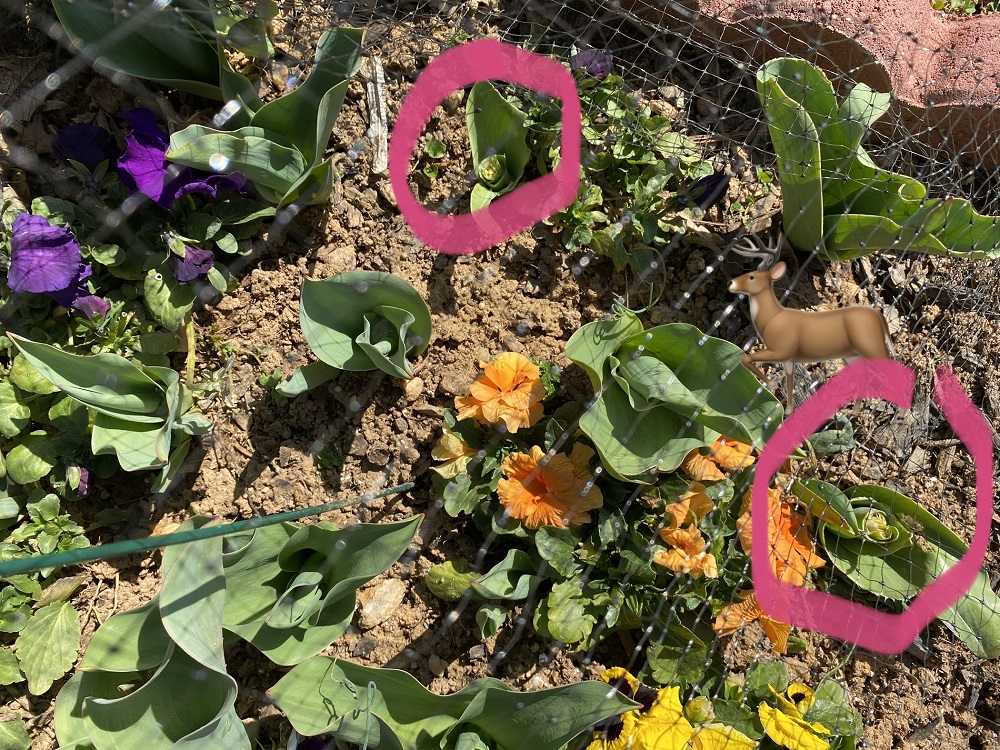
Second Problem: Slugs eat some plants and flowers, too
The pansies were another challenge. I planted them in fall, and at first they looked so nice, but then something else got them. Not the deer. We realized then from the pattern of destruction that we also had a slug problem. You could tell, because the flowers were disappearing in bits and pieces, like notched in their appearance, and holes in the middle of the petals. We had a similar problem with the beautiful fall dahlias.
Solution for Garden Slugs: Iron pellets
So, I went to the hardware store and bought some slug pellets. Apparently, it is some type of iron molecule that the slugs will eat, but it makes them croak. I hate the idea of hurting animals, even slugs, but I didn’t pay hundreds of dollars for all these plants to have them disappear each night. My mom is solidly senior in her years, and she is going to get some darn beautiful flowers in her yard before her time comes!
After sprinkling the pellets around, the pansies really filled in amazingly well, before the tulips came up between them. One problem was that the net was also smashing down on the pansies on the edge of the garden too much. In spring, the tulips came up beautifully. But I was right about the net being too low for the the tulip flower tops to look nice. They were all mashed down once they hit the net. Very pretty though, and the deer could not eat them — 3/4 of the way there.
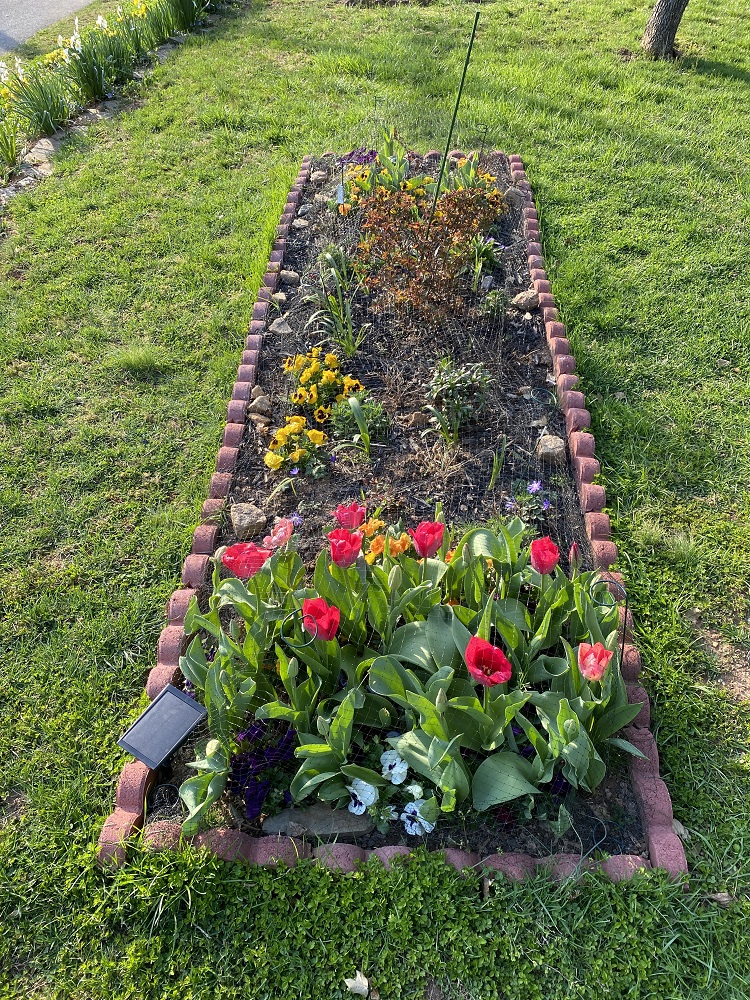
Revised Deer Solution #1: Raised bird netting
By the time I came up with a better idea, and purchased the parts to try it out, it was too late for the tulips. I decided to put some taller stakes around the perimeter of the garden. The ones I chose were green with a hollow metal core; not too expensive, so I thought they would do. As soon as I put them in the garden it was clear that I had chosen stakes that were way too long. It looked stupid. So, I went back to the store and bought some more that were shorter — about 3 feet high instead of the longer 4-5 foot ones that I had bought at first. Once in the ground, the shorter ones looked okay. Tall enough for the tulips next year and also for the central knockout rose to grow.
The other product that the hardware store had was something like “ground staples” which are designed to be used with bird netting. They were just U-shaped bits of metal about 4 inches long; easy to put in and pull out. They really were very helpful, and did not present the same problem with the net edges pushing down a lot of the flowers near the brick borders. I had intended to use twist-ties to hold the net up, but once I cut it, and made it tight enough, the net stood up fine on its own. The piece of net I had originally cut was not quite big enough. It only covered 3 sides and the top, but that was all right. I took some of the smaller pieces that she had used on other plants, and stitched them together for the final side. This will allow her to pull the staples out and reach in to clean up the expired plants and weeds.
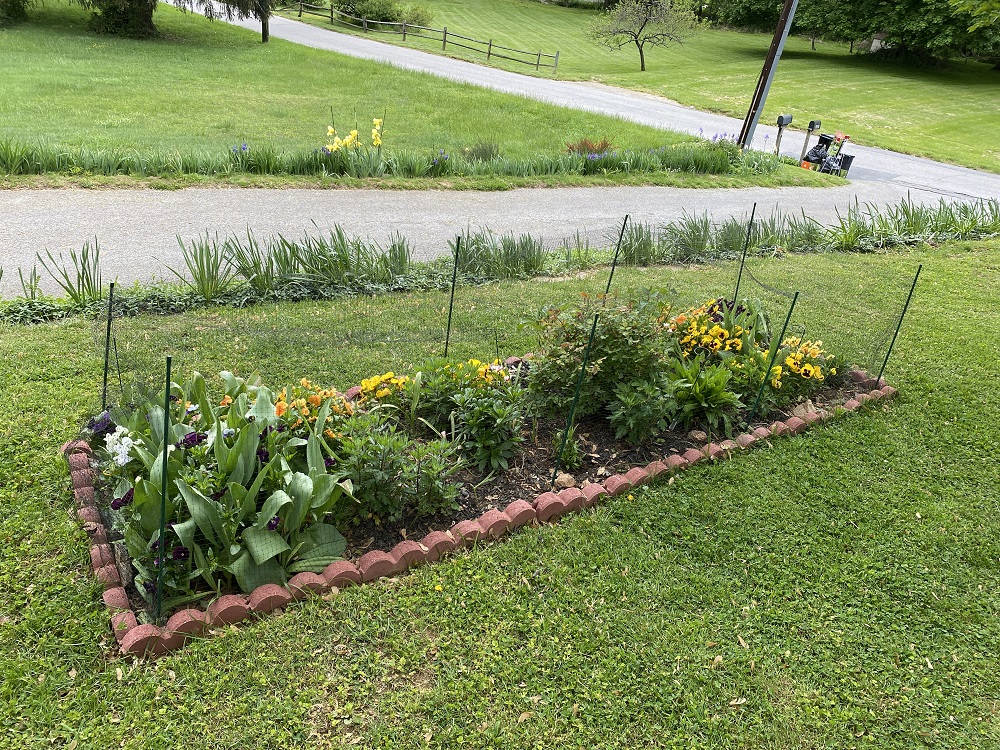
So, here’s the final result. I think it looks better than what we were doing — as though someone actually planned it out this time. No, it’s not invisible and it is not ideal for the aesthetics of the flowers. But many deer have been through they yard many times Not one deer bothered it — did not step on it, or stick their nose in it. All of the stakes are standing just as we put them in. I think it is a winning solution, for now. The roses bloomed, and all of the bulbs and the pansies lasted beautifully from September to June. Would not have been possible without protection.
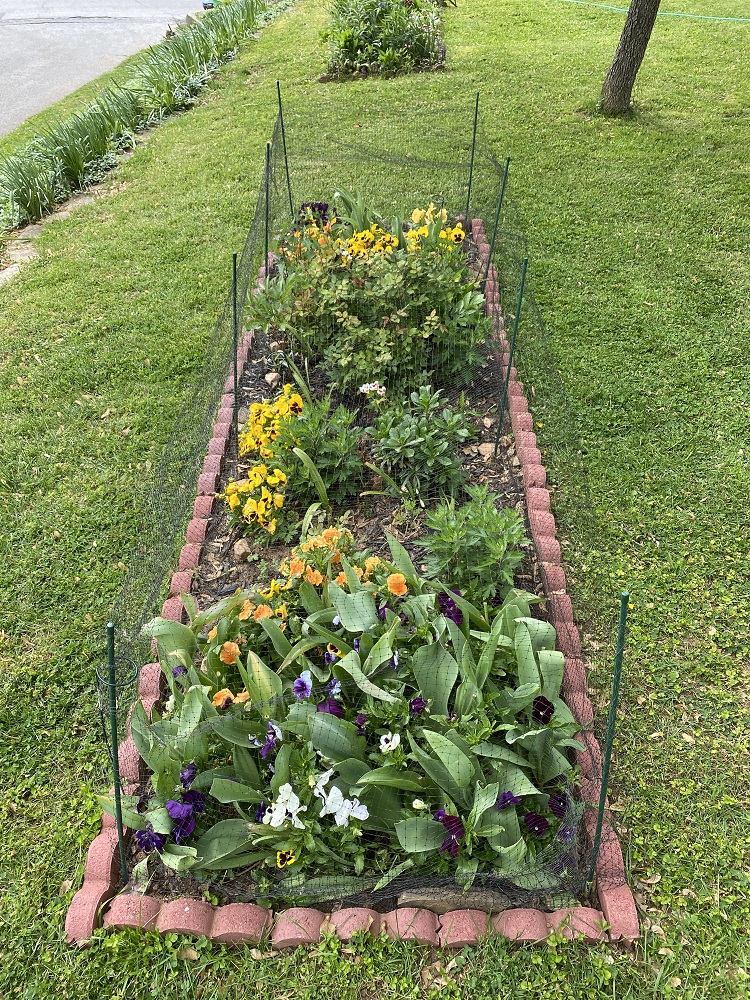
Deer Solution #2: Spray that smells strong
We also got some smelly deer repellant. Apparently deer just hate anything that smells strong. We tried to plant lots of marigolds — lots and lots of marigolds — last year, and they looked terrific. The deer did not touch them, but the marigolds’ smell did not keep the deer away from the rest of the plants. So, my mom is testing out the deer spray I bought her. (Bobbex is the brand I chose.) It seems to have worked. We had many more deer come through. And they did munch a few of the unprotected plants, but mostly passed over the ones that had been sprayed. She missed one bed of hostas, and the deer ate all of those but not the hostas that had been sprayed. Pretty incredible.
Now, the spray does smell, especially on the first day of application — kind of like a zoo, really. Not something you want to get on your clothes or skin. But it does definitely work. As I said, mom is elderly but she was able to apply the spray adequately for protection. All of the pretty flowers survived, but initially it is moderately unpleasant. Instruction indicate that the spray should be reapplied every couple of weeks. I think she’s done it more like every 3 weeks, and it has been fine, despite lots of rain.
Deer Solutions #3: Plant flowers that they do not like to eat
The other idea, is to just plant “deer-resistant” plants. Things that deer find distasteful to begin with. Her original small garden, as I said earlier, was not doing very well. She did have a large shady tree cut down, and that helped a lot to choose a different bunch of plants. So, for bulbs, we had lots of hyacinths, with some daffodils and narcissus, hellebore, and a couple of primrose for early spring. And then a lot of other stuff for later spring — candytuft, pentas, yarrow, English daisy, snapdragons, and more that I cannot recall. None of them have been eaten, but some of her original leafy things got taken down the other day. Nothing is perfect. More deer spray, I suppose.
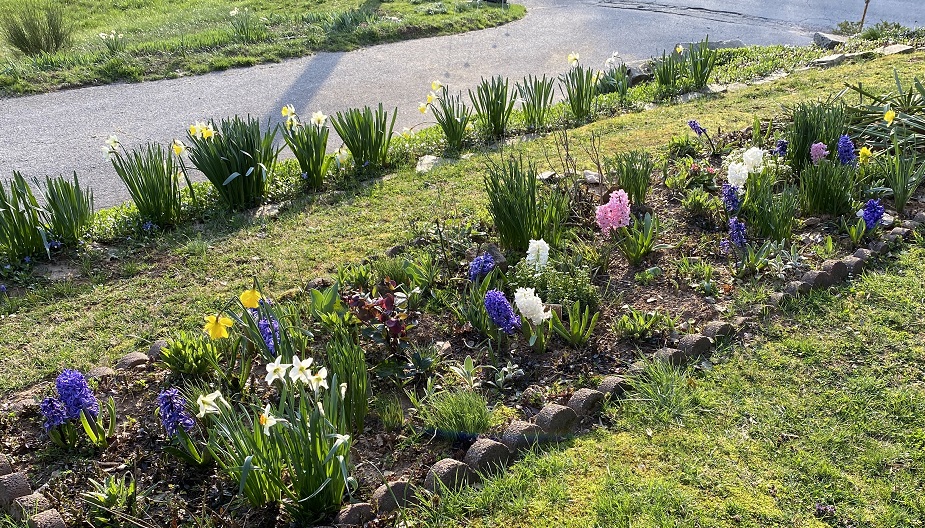
Proven Deer-Resistant Flowers (So Far)
- Crocus (small flowers with grass-like leaves, early bloomers, mostly yellow and purple)
- Snowdrops (small flowers, long stalks with cute but small, brief white flowers)
- Allium (purple balls atop long onion stalks)
- Hyacinths — (low-growing bunches of flowers on a stalk; pink, white and purple).
- Grape Hyacinths (smaller version with purple flowers atop stalks) .
- Daffodils (mostly yellow flowers on green stalks, different shape varieties).
- Narcissus (similar to daffodils, but white).
- Lilly of the valley (Mostly low, thick green leaves with some brief white bell-shaped flowers; spread kind of weedy, though).
- Yarrow (groupings of small flowers on stalks with low-growing leaves).
- English daisies (cute puffy little flowers, pink and red with yellow centers).
- Candytuft (small bushy plants that grow lots of flowers, pink and white).
- Hellebore / Lenten Rose (green leaves through the winter, bloom as down-pointing pale flowers in shades of pale pink, purple and greenish hues).
- Marigolds (bushy plants with lots of flowers, strong unique smell, yellow, orange, red).
- Pincushion flowers (small leafy plants that grow clover-like purple and pink flowers on the ends).
- Bachelor’s buttons (tall stalks with some small flowers, purple, pink, white).
- Iris (large, beautiful, delicate flowers on tall stems with leafy bases, often purple, but also yellow, white, pink, blue, deep purple and red) .
- Hens and Chicks (small geometric succulents).
- Foxglove (tall plants that grow bunches of pretty bell-shaped flowers at the top).
- Rosemary (an evergreen bush and edible herb that does grow a few brief flowers in the spring).
- Crape Myrtle (dwarf bushes or tree-sized plants with bunches of flowers in purple, pink, red and white).
- Heather (small ground-level bushes with pine-like leaves. that briefly grow rows of tiny pink or white flowers on the branches).
- Verbena (ground-level perennial, plants that branch out in leafy stems with bunches of colorful flowers; purple, pink, white, red).
- Lantana (annuals that are similar to verbena, but more woody stems, and very bright multi-colored flowers, mixtures of red, yellow, pink, white).
- Johnson’s geraniums (ground cover plants with lots of blue and pink flowers).
- Peony (bushy plants that have big fluffy flowers; pink, white and red).
- Bleeding heart (perennials that grow about 2 feet tall, and have stems that have rows of pink flowers on the ends, that look like their namesake)
- Blanket flower (small perennial plants that grow lots of colorful flowers, similar to marigolds, in yellow and red)
- Coreopsis (small plants with long stems that produce lots of bright yellow flowers)
- Vinca (annual flowers that produce several stems with small pretty flowers on each tip from summer through fall; white, pink, purple, red)
- Vinca vine / Periwinkle (year-round ground cover the produces blue-violet flowers briefly in fall)
- Lambs ear (fuzzy gray-green leaves on mostly ground-level plant with some short stalks and pale violet blooms)
- Veronica / Speedwell (small plants with long shoots that have purple flowering tips, bees love)
- Columbine (such curious shooting-star-shaped, double-petal flowers, grow on stems in different colors, and point somewhat downward)
- Forsythia (large bushes with long branches that briefly grow gorgeous golden blooms all over in early spring)
- Poppy (cute blooms on top of long straight stems, red and orange)
- Snapdragon (small annual plants that have short stems that grow bunches of flowers in different colors)
- Aster (perennial plants that in produce small bushes of woody stems and in fall, lots of pretty flowers with thin petals; pink, blue, purple, white usually with a yellow button center)
- Butterfly Bush (a woody perrenial plant that regrows each year, and has long stems with spear-like groups of blooms (magenta, purple, white, lavender)
- Astilbe (small fern-like plants that produce a single stem with a fuzzy Christmas-tree like flower in pink, red, white)
- Scotch Broom (evergreen bushes that produce a brief but spectacular bloom of color; deep pink, yellow, fiery orange)
- Pacysandra (always green ground cover that briefly produces small white flowers)
- Blue-Eyed Grass (not actually grass, but long grass-like stems from a small central base, with pretty bluish blooms that open in the sun)
- Phlox (mostly ground cover that grows in early spring, and blooms in lots of beautiful colors all over for a short while)
- Primrose (low to the grown, bright flowers)
- Evening Primrose (bright yellow flowers that return each year)
- Clematis (perennial climbing vine star-like blooms)
- Caryopteris (perennial bushy plant with beautiful blue flowers)
- Chinese lantern (stems that produce unique looking bright orange flower that are like hollow balloons)
- Oxalis (small perennial, plants that look like large purple clovers, have small pink blooms)
- Coleus (annuals with very colorful leaves, yellow green to deep red)
- Butterfly Bush (long stalks with spears of flowers in violet, red)
Not Deer Proof, But Less Preferred
- Chrysanthemums (lots of colors in fall, may nibble on the tips)
- Salvia (it depends, there are lots of salvia varieties, and deer stay away from some of our purple ones with the smelly leaves, but gobble up all of the ones with the pretty red tips)
- Hibiscus / Rose of Sharon (large purple, white or red flowers)
- Portulaca / Mexican Rose (small plants, somewhat like ground covering succulent, red, white, yellow, pink)
- Ice Plant (another low ground, succulent like plant that produces bright pink or yellow flowers)
- Begonia (short plants with bright flowers and thick leaves, some waxy; different colors)
Not at All Deer-Proof or Deer-Resistant
- Roses
- Liatris
- Impatiens
- Azalea
- Hollyhocks
- Tulips
- Yucca
- Hydrangea
- Day Lily
- Tiger Lily
- Canna Lily
- Sedum (pink flower-topped bunches)
- Shasta Daisies
- Black-Eyed Susan
- Dahlia
- Gladiolas
So, three different solutions — none is exactly free, and each has benefits and flaws. But for a low maintenance and not too, too expensive set up, I think it will do fine. Mom is happy and she’s had more flowers this year than maybe ever before. And that makes me happy, too.

A look at some of the furry denizens that visit our yard each day:


